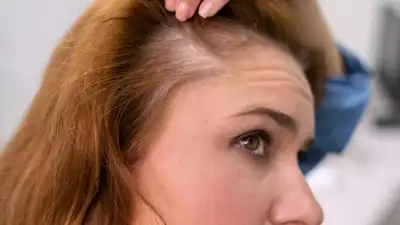ARTICLE AD BOX

Spotting subtle hair changes early can combat potential hair loss. Thinning ponytails, a widening part, or excessive shedding are key indicators. Conditions like alopecia areata and traction alopecia from tight hairstyles also contribute. Stress, health issues, and underlying conditions can trigger hair loss. Early detection enables timely intervention, preventing further damage and addressing root causes for better hair health.
M
aybe it’s not always about how many strands of hair you find on your pillow after you wake up in the morning. Or, how messy does the rubber band look when you take it off your ponytail.
Hair loss can sneak up on anyone, and when it does, it’s about spotting those subtle changes. Like noticing how thinner your braid seems. Or, how wider that middle part has grown to be. Because these minor changes could be whispering something important: early signs of hair loss, and spotting it early can make all the difference.Spotting hair thinning early is your secret advantage. It’s like seeing smoke before the fire.
Whether you're male or female, traction from tight styles, sudden stress-related shedding, or even simple hereditary patterns could be behind what you see. If you catch it now, you can act swiftly, from gentle hair care habits to simple medical steps.
This article points to exactly that; it shows you what to watch for so you can pause hair loss in its tracks, before it’s too late.
Early signs of hair loss (you shouldn’t ignore)
Thinning ponytail and wispy hairEver wrap your hair tie twice and still feel your ponytail looks, well, skinnier than it was before? Or, try a messy hairstyle, only to end up noticing that the hairstyle doesn’t look full enough? These are the sneakier early hints of hair thinning.
A thinning ponytail, brittle strands, too many split ends, or wispy baby hairs around the scalp, as per dermatologists, can signal that hair density is dropping. So, pay attention.Wider part (means, more visible scalp)This one’s one of the shortest horror stories ever! Finding your scalp peeking through the part or at the top of your head while combing your hair? While scalp visibility isn’t uncommon, noticing that your scalp is getting more visible day by day can be and is quite worrisome.
That’s common in both men and women, with men seeing a receding hairline or thinning on the crown, and women often noticing a widening part. Final verdict? Hair isn’t where it’s supposed to be.Receding hairline or extra sheddingFor men, it’s easiest to take note. They may recognize the classic “M”-shaped hairline or thinning temples as they age. But don’t dismiss excessive hair in your brush or shower drain just because you’re adding years to your age. Sometimes, hair loss creeps up way more rapidly than being in sync with aging.
While losing around 50 to 100 hairs a day is normal, going beyond that could hint at trouble. Random bald spots and scalp sensationsSpotting small circular bald patches that appear suddenly, or feeling tingling, or mild itching around them? These could be signs of alopecia areata, an autoimmune condition that causes hair loss, typically in small, round, and smooth patches on the scalp. The immune system mistakenly attacks hair follicles, leading to hair shedding.
This condition is not contagious and usually affects individuals who are otherwise healthy.
So, stay vigilant for any sudden and unexpected bald patches.Tight hairstyles cause traction alopeciaToo savvy with wearing your hair up high? Ponytails, tight braids, buns, and any hairstyle that tugs repeatedly at your scalp may lead to traction alopecia. It’s a form of hair loss caused by continuous, repetitive pulling or tension on hair follicles, often from hairstyles like tight braids, ponytails, or extensions, and this form of hair loss often affects the hairline, especially along the temple regions.
This prolonged tension can damage the follicles, leading to hair shedding and potentially permanent hair loss if not addressed.
Stress or health-related shedding (telogen effluvium)Stress, illness, sudden hormonal changes or weight loss, or even busting a move in a serious workout can push your hair into a shedding phase. This form, called telogen effluvium, is a common form of temporary hair loss that can cause rapid loss. This shedding often follows a stressful or traumatic event for the body, such as physical or emotional stress or even certain medications.
It occurs when a large number of hair follicles enter the resting phase (telogen) prematurely, leading to increased shedding.
But the good news is it’s often temporary once the trigger is addressed.Underlying health red flagsSometimes, hair loss is more than cosmetic; it’s a health signal. Conditions like thyroid disorders, iron deficiency, PCOS, or even autoimmune issues can cause thinning or patchy loss. If baldness goes hand in hand with fatigue or skin changes, it’s wise to see a doctor.
Hair fall vs hair loss: What’s the difference
Now, you might be wondering what makes hair loss different from regular hair fall. Although hair fall and hair loss are often used interchangeably, medically, they have distinct meanings. Hair fall refers to the natural shedding of hair as part of its growth cycle, while hair loss signifies a more significant, often permanent, reduction in hair volume or a failure of hair to regrow. Normal hair fall is a daily occurrence, with individuals typically shedding 50-100 hairs, while hair loss is characterized by excessive shedding, bald patches, or thinning.
Why early detection matters
Catching early signs means you can stop things from getting worse. Whether it’s changing your hair care, using treatments like minoxidil, or checking for health issues, acting early gives you a real edge.Moreover, sometimes hair loss signals more than just genetics. Things like thyroid issues, PCOS, anemia, vitamin D deficiency, or stress-triggered shedding (telogen effluvium) can all play a role. Spotting the signs early helps you find the root cause and tackle it.None of us is a Rapunzel here, but that doesn’t mean being completely unaware of our hair health, does it?!Disclaimer: This article is for informational and educational purposes only. It is not a substitute for professional medical advice, diagnosis, or treatment. Always consult a licensed healthcare provider for questions about hair loss or before starting any treatment. Reliance on the information here is at your own risk.
Meghan Markle’s Royal Tantrum: Calls Palace ‘Too Small’, Sparks Megxit Storm



.png)
.png)
.png)
















 1 hour ago
5
1 hour ago
5










 English (US) ·
English (US) ·